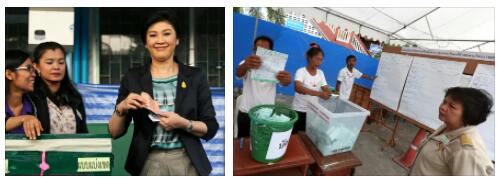Thailand History
In official historiography, modern Thailand is in line with the earlier Buddhist kingdoms Sukhothai (approx. 1240-1438) and Ayutthaya (1351-1767). In quasi-feudal societies based on rice cultivation and trade, the majority of the population were serfs (phrai) or slaves (taht). The kingdoms were almost constantly with competing power centers in Angkor (Cambodia) and Burma in the war. During mutual raids, which also involved the kidnapping of workers, the cities of the enemy were repeatedly plundered and the expansionthe rich redefined. After Ayutthaya was destroyed in 1767, the general Taksin founded a new kingdom in Thonburi (Bangkok). He was overthrown in 1782 by Phra Phutthayotfa, who founded the Chakri dynasty (Rama I), which is still ruling today.
A peculiarity of Thai history is that Thailand is the only country in Southeast Asia that has never been colonized. Under pressure from the British Empire in Burma and France in Indochina, a group of modernizers around the kings Mongkut (Rama IV, 1851-1868) and Chulalongkorn (Rama V, 1868-1910) managed to transform Siam into an independent nation state. With the “ Bowring Treaty ” in 1855, they made extensive economic concessions to the British colonial power (e.g. with regard to their teak interests in the north), which integrated Siam into the new, capitalist world economy. At the same time they centralized state power (including tax collection, military) against the previously powerful noble families (sakdina) and consolidated them territorial control of Bangkok over hitherto relatively independent centers such as Chiang Mai, Lamphun and Luang Prabang.
Development of today’s state
The emergence of modern Thailand goes back to the revolution of 1932, in which civil officials (around Pridi Banomyong) and officers (around Phibun Songkhram) rebelled against the absolute monarchy and enforced a constitutional monarchy and a democratic constitution. Since then, however, the military have mostly ruled. Thailand was a mainstay of the US during the “cold war”. A second democratic awakening took place in 1973 after a student revolt overthrew the military regime. This movement was bloodily suppressed in 1976 on the Thammasat University campus. Many of the student activists initially joined the armed struggle of the Communist Party of Thailand. After the reign of General Prem Tinsulanond and a gradual political liberalization, another coup led to the democracy movement of May 1992.
The monarchy
Thailand’s King Bhumibol has been head of state since 1946 and is usually portrayed as a popular monarch. Critical analyzes of recent years (such as the biography of Paul Handley, which is banned in Thailand, or the “ network monarchy” analysis by British political scientist Duncan McCargo) show a more contradicting picture. The king only became a benefactor of his people in the context of the Cold War under Field Marshal Sarit Thanarat In close cooperation with the military, the network of veteran generals such as Prem Tinsonuland, high officials, members of the royal advisory board and his investment fund (Crown Property Bureau) important fortunes of the country. Critical voices about the monarchy are punished with up to 15 years imprisonment in the law against lese majesty (Lèse Majesté). Despite the Lese Majesty Act, one of the favorite pastimes of the Thais is gossip about the royal family and speculation about the succession to the throne. The new king Maha Vajiralongkorn is notorious as a playboy and does not enjoy the same respect as his father.
The military
The military has played a central political role since the 1932 revolution. Phibun Songkhram was rather fascist and against the monarchy. Only with the coup of Sarit Thanarat in 1957 would the monarchy be re-established. With numerous coups and military dictatorships, the military dominated the country’s politics during the Cold War. Many prime ministers were generals. After the bloody suppression of the democracy movement by General Suchinda Kraprayoon in May 1992 , the political role of the military was severely discredited, so that some assumed that the army was “professionalizing” and depoliticized. But with the 2006 coup the generals intervened again in the country’s domestic politics. A military regime has ruled Thailand since 2014. Today the military is still marked by factional struggles. The monarchy installed personal favorites, Generals Chalermchai Sitthisart (2016-18) and Apirat Kongsompong (2018-20) as Commander in Chief. The influence of the ultra monarchist faction “Red Rim” is growing at the expense of the “Eastern Tigers” by Prayuth Chanocha.
Thaksin
Thaksin Shinawatra and his party Thai Rak Thai (“Thais love Thais”) won the election in 2001 after polarizing against the requirements of the International Monetary Fund (IMF) with nationalistic rhetoric after the Asian crisis. In the following years he implemented his extensive election program, which combined a dynamization of the export economy with accompanying social programs. The introduction of a tax-financed health system (the ” 30 baht program”) and the “1 million baht program” (microcredit for each village) were particularly popular. Thai Rak Thai received support from the next due to increasing support in the north, northeast and Bangkok Elections in 2005 the absolute majority. At the same time, Thaksin enjoyed the support of large Thai corporations such as the agribusiness company Charoen Pokphand, which was criticized for scavery in the shrimp industry. Thaksin has lived in exile since the coup. The Thaksin camp includes the TRT successor parties, People’s Power Party (PPP) and Phüa Thai (“For Thailand”). The latter won the election in 2011; Thaksin’s sister Yingluck Shinawatra became prime minister. In 2014 she was dismissed by the Constitutional Court for abuse of office.



